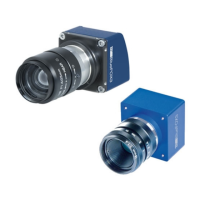// Master: Set timers to trig image: Start after queue is filled
GenICam::CounterAndTimerControl catcMaster(pDev);
catcMaster.timerSelector.writeS( "Timer1" );
catcMaster.timerDelay.write( 0. );
catcMaster.timerDuration.write( 1000000. );
catcMaster.timerTriggerSource.writeS( "Timer1End" );
catcMaster.timerSelector.writeS( "Timer2" );
catcMaster.timerDelay.write( 0. );
catcMaster.timerDuration.write( 10000. );
catcMaster.timerTriggerSource.writeS( "Timer1End" );
See also:
Counter And Timer Control
Note:
Make sure the Timer1 interval must be larger than the processing time. Otherwise, the
images are lost.
The timers are defined, now you have to do following steps:
Set the digital output, e.g. "Line 0",1.
connect the digital output with the inputs of the slave cameras, and finally2.
set the trigger source to the digital input, e.g. "Line4".3.
Set digital I/O
In this step, the signal has to be connected to the digital output, e.g. "Line0":
// Set Digital I/O
GenICam::DigitalIOControl io(pDev);
io.lineSelector.writeS( "Line0" );
io.lineSource.writeS( "Timer2Active" );
See also:
Digital I/O Control
This signal has to be connected with the digital inputs of the slave cameras as shown in Figure 1
and 2.
Set trigger
"If you want to use Master - Slave":
// Set Trigger of Master camera
GenICam::AcquisitionControl ac(pDev);
ac.triggerSelector.writeS( "FrameStart" );
ac.triggerMode.writeS( "On" );
ac.triggerSource.writeS( "Timer1Start" );
// or ac.triggerSource.writeS( "Timer1End" );
// Set Trigger of Slave camera
GenICam::AcquisitionControl ac(pDev);
ac.triggerSelector.writeS( "FrameStart" );
ac.triggerMode.writeS( "On" );
ac.triggerSource.writeS( "Line4" );
ac.triggerActivation.writeS( "RisingEdge" );
See also:
18 Use cases
247

